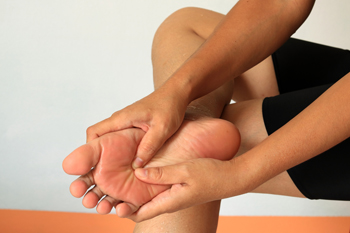 The sesamoid bones in the body are typically linked together by tendons, which differs from other bones that are connected by joints. There are two small bones that are located on the side and bottom of the foot, and they help to move the big toe. If these bones become damaged from overuse, the condition that is referred to as sesamoiditis may occur. Some of the symptoms that are associated with this ailment can consist of difficulty in moving the big toe, feeling pain on the bottom of the foot, and swelling or bruising of the affected area. After a proper diagnosis is performed, which generally consists of having an X-ray or MRI taken, the correct treatment can begin. This can start with temporarily stopping the activity that may have caused the pain, and wearing shoes that are comfortable, preferably with a low heel. If you feel you have injured your sesamoid bones, it is advised that you seek the counsel of a podiatrist.
The sesamoid bones in the body are typically linked together by tendons, which differs from other bones that are connected by joints. There are two small bones that are located on the side and bottom of the foot, and they help to move the big toe. If these bones become damaged from overuse, the condition that is referred to as sesamoiditis may occur. Some of the symptoms that are associated with this ailment can consist of difficulty in moving the big toe, feeling pain on the bottom of the foot, and swelling or bruising of the affected area. After a proper diagnosis is performed, which generally consists of having an X-ray or MRI taken, the correct treatment can begin. This can start with temporarily stopping the activity that may have caused the pain, and wearing shoes that are comfortable, preferably with a low heel. If you feel you have injured your sesamoid bones, it is advised that you seek the counsel of a podiatrist.
Sesamoiditis is an unpleasant foot condition characterized by pain in the balls of the feet. If you think you’re struggling with sesamoiditis, contact one of our podiatrists of Active Foot and Ankle Care, LLC. Our doctors will treat your condition thoroughly and effectively.
Sesamoiditis
Sesamoiditis is a condition of the foot that affects the ball of the foot. It is more common in younger people than it is in older people. It can also occur with people who have begun a new exercise program, since their bodies are adjusting to the new physical regimen. Pain may also be caused by the inflammation of tendons surrounding the bones. It is important to seek treatment in its early stages because if you ignore the pain, this condition can lead to more serious problems such as severe irritation and bone fractures.
Causes of Sesamoiditis
- Sudden increase in activity
- Increase in physically strenuous movement without a proper warm up or build up
- Foot structure: those who have smaller, bonier feet or those with a high arch may be more susceptible
Treatment for sesamoiditis is non-invasive and simple. Doctors may recommend a strict rest period where the patient forgoes most physical activity. This will help give the patient time to heal their feet through limited activity. For serious cases, it is best to speak with your doctor to determine a treatment option that will help your specific needs.
If you have any questions please feel free to contact our offices located in Fair Lawn, Riverdale, and Englewood, NJ . We offer the newest diagnostic and treatment technologies for all your foot and ankle needs.
Read more about Sesamoiditis





